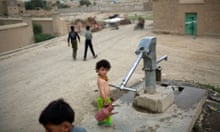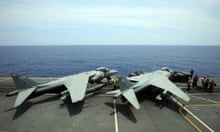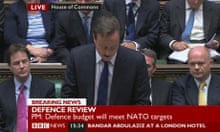Britain's armed forces will no longer be able to mount the kind of operations conducted in Iraq and Afghanistan, the government's strategic defence review made clear today. For at least a decade it will also be impossible to deploy the kind of carrier taskforce which liberated the Falklands 28 years ago.
Though defence chiefs said today they will still have significant expeditionary forces, they will not be able to intervene on the scale of recent years. According to new defence planning assumptions, UK forces will be able to carry out one enduring brigade-level operation with up to 6,500 personnel, compared to the 10,000 now in Afghanistan, plus two smaller interventions, at any one time.
Alternatively, they will be able to mount a one-off, time-limited major intervention – "with sufficient warning" – of up to three brigades with about 30,000 personnel, which is two-thirds of the force deployed to Iraq in 2003.
Cherished projects will be delayed, cut or dumped in an attempt to recoup a massive overspend in Britain's defence budget, which faces a black hole of £36bn. In the MoD, 25,000 civilian jobs will go, along with 17,000 from the armed forces. The £38bn annual defence budget will be cut by 8% over the next four years.
The construction, mainly in Scottish shipyards, of two aircraft carriers – the largest ships ever built for the navy – will go ahead even though there will be no planes to fly from them until 2020 at the earliest. That is because the existing fleet of Harriers will be scrapped immediately and an as yet unknown number of US Joint Strike Fighters due to replace them will not be ready for another 10 years.
HMS Ark Royal will also be scrapped immediately, while HMS Illustrious or HMS Ocean will continue for now as a helicopter carrier. The new carriers, the Queen Elizabeth and Prince of Wales – costing more than £5bn between them – will be ready by 2020. The former is likely to be mothballed without an aircraft having ever flown from her and the latter adapted to take a cheaper version of the JSF, which will use catapults to take off. The contract meant that scrapping the order for the second carrier would cost more than building her, David Cameron told MPs.
In an expected and politically convenient move – though sharply attacked by some Conservative backbenchers – the government put off a decision on replacing the existing fleet of four Trident nuclear missile submarines until after the next general election, due in 2015. As part of a "value for money" exercise, the number of warheads aboard each sub will be reduced from 48 to 40, the total number of operationally available nuclear warheads reduced from fewer than 160 to no more than 120, and the UK's nuclear weapons stockpile set at a maximum of 180 – a cut of 25%.
The moves will save £1.2bn and put off a further £2bn of expenditure in a programme officially estimated to cost an initial £20bn. Delaying a decision on a replacement warhead will save a further £500m in the short term. The Lib Dems had been pressing for a delay, saying a decision to replace the Trident submarines was not needed now.
The government also decided to:
Withdraw 20,000 British military personnel will be withdrawn from Germany by 2020.
Scrap the long-delayed Nimrod MRA4 maritime reconnaissance aircraft on which £3.5bn – more than the total cut in the defence budget over the next four years – has been spent. RAF Kinloss in Scotland is likely to close as a result.
Cut navy personnel by 5,000 to about 30,000. The number of destroyers and frigates will be cut from 23 to 19 and the navy will loose an amphibious landing vessel. The future of the Dartmouth naval college is uncertain.
Reduce the size of the army by 7,000 to total about 95,000 though the infantry will not shrink.






Comments (…)
Sign in or create your Guardian account to join the discussion